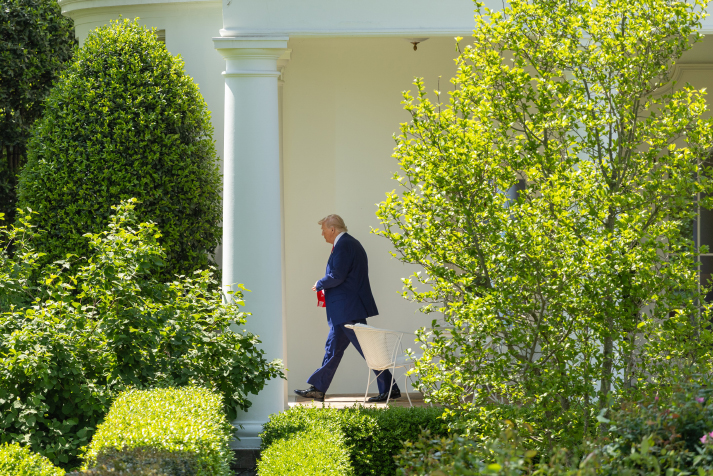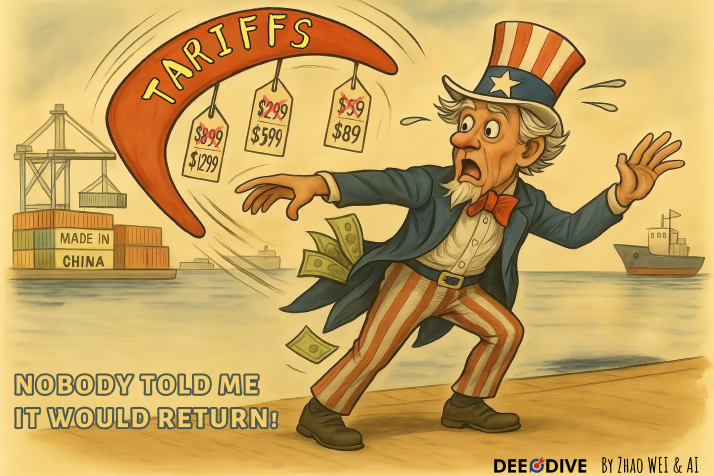| Pacific Dialogue |
| A hundred days of chaos | |
|
|
 U.S. President Donald Trump walks toward the South Lawn to board Air Force One at the White House in Washington, D.C., the U.S., on April 29 (XINHUA)
On April 30, U.S. President Donald Trump completed the first 100 days of his second term, with both domestic and international assessments of his performance remaining largely negative. A joint poll released on April 27 by ABC News, The Washington Post and market research firm Ipsos found that only 39 percent of Americans approve of the way Trump is handling his job—setting a new low for any U.S. president at this point in a term, breaking the previous record low of 42 percent, which he set during his first term. Against the backdrop of a deeply divided American society, polling data alone cannot tell the whole story. However, by any measure, Trump's return to the White House has been more successful in bringing unprecedented chaos than in reshaping the global or domestic order. During his campaign, Trump styled himself as a reformer, promising voters a streamlined government and a crackdown on systemic corruption. In reality, much of his effort has focused on dismantling traditional checks on presidential power, relying heavily on executive authority to push through policies. In the abovementioned poll, 62 percent of respondents said the Trump administration does not respect the rule of law, while 64 percent criticized it for overextending presidential power. The new Trump administration is facing considerable political pressure. On one hand, Trump made unorthodox appointments, elevating relatively young figures with limited political experience—such as J.D. Vance as vice president and Pete Hegseth as secretary of defense—to top government posts. Yet the administration has repeatedly committed basic errors in handling matters of national security.  ZHAO WEI & AI
For example, Hegseth was reported twice in the first 100 days to have leaked U.S. military plans in messenger service group chats, raising widespread concerns about his suitability for the role. Additionally, internal divisions within Trump's team have become increasingly visible. A notable example came on the 100th day of Trump's second term, when White House Chief of Staff Susan Wells announced that Elon Musk—who had played an instrumental role in Trump's election and was effectively heading the so-called Department of Government Efficiency—was no longer working at the White House. During this period, Musk had reportedly engaged in repeated clashes with senior cabinet members, including Secretary of State Mark Rubio, Treasury Secretary Scott Bessent and senior trade and manufacturing adviser Peter Navarro. More notably, the divide between Democrats and Republicans is widening. Unlike the long-standing partisan rivalries within Capitol Hill, the rift is increasingly playing out between states with opposing political orientations. On April 16, California Governor Gavin Newsom, a Democrat, announced that the state would file a lawsuit against the Trump administration over tariffs—becoming the first in the nation to do so. Newsom said he was seeking to strike agreements with foreign partners to shield California from retaliatory measures triggered by Trump's intensifying trade war. In a May 2 interview with Nikkei Asia, Newsom repeatedly underscored the "distance" between California and Washington, D.C.—both geographically and ideologically. "We're 2,000 miles away from Washington, D.C. But we're a world away in terms of our mindsets. I represent the most un-Trump state in America," he said. Tariffs have emerged as one of the most contentious topics in Trump's first 100 days of his second term. In the aforementioned poll, 64 percent of respondents disapproved of his decision to impose tariffs on imported goods. Additionally, 71 percent believed that the tariff policy would worsen inflation, while 72 percent expressed concern that Trump's broader economic agenda could lead to a recession in the near term. Trump has launched a sweeping trade offensive against much of the world, defying conventional economic wisdom. He appears to believe that a combination of hardball tactics and transactional thinking can pressure other countries into aligning with U.S. interests—just as he attempted to do in 2018. However, an increasing number of countries have chosen to defend their own interests. China, the world's largest trading nation in goods, is at the forefront of this group. China has chosen not to compromise in the face of U.S. bullying. On April 29, China's Ministry of Foreign Affairs released a video to convey China's firm stance of not yielding to hegemony. The video states: "China won't back down, so the voices of the weak will be heard, bullying will be stopped and justice will not disappear from the world." The Washington Post commented that the video was the latest example of Beijing's defiant response to Trump's trade war, which has thrown the relationship between the world's two largest economies into turmoil and provided an opportunity for China to cast itself as a more reliable global superpower. While China's forceful countermeasures were perhaps expected, what even the U.S. may not have anticipated was the firm stance taken by its traditional allies—including the European Union, Japan and Canada—on the issue of tariffs. Canada, in particular, responded with unusual resolve. Early in his presidency, Trump had publicly referred to Canada as the "51st state of the United States," sparking widespread outcry around the world. Many observers believed that Trump's territorial rhetoric toward neighbors such as Canada and Mexico was not a literal annexation attempt, but rather a tactic of intimidation designed to gain leverage in subsequent trade negotiations. At the beginning of this year, Canada's ruling Liberal Party was polling at just 16 percent—the worst showing in its history. However, Trump's coercion and insults awakened Canadian voters to the realization that what the country needed most was a leader capable of managing relations with the U.S. It was with this defiant stance that the Liberal Party staged a political comeback. Newly elected Prime Minister Mark Carney openly vowed to defeat the United States in the trade war and declared that Canada would never forget America's betrayal. All of these events have taken place in the first 100 days of Trump's second term. Trump issued 178 executive orders and memoranda during this period—an extraordinary number that nearly rivals the total issued by former President Barack Obama over his entire four-year first term of 1,461 days. BR Copyedited by G.P. Wilson Comments to liangxiao@cicgamericas.com |
|
||||||||||||||||||||||||||||||
|